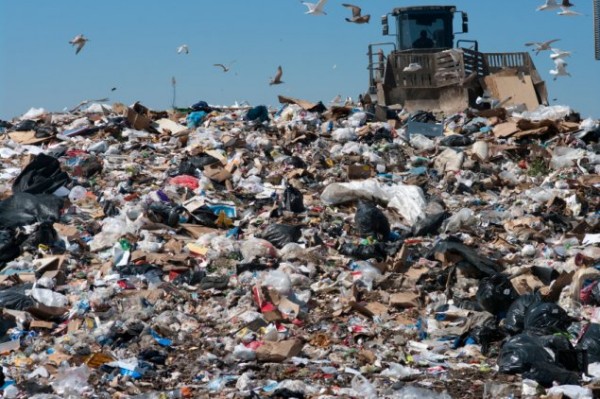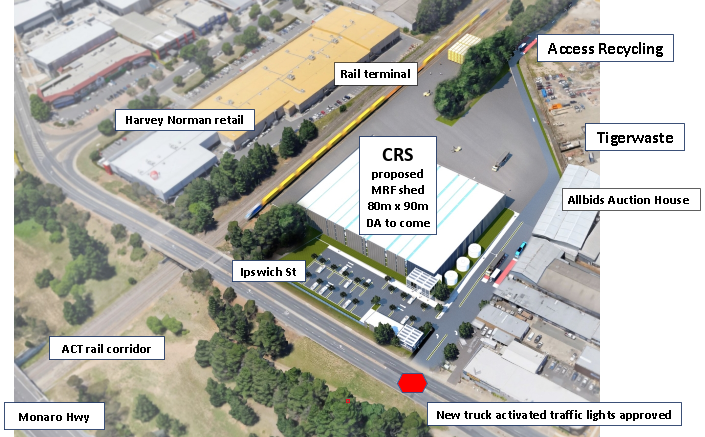
Capital Recycling Solutions says its proposed Fyshwick plant will divert 300,000 tonnes of waste from landfill. Photo: File.
The ACT Government’s decision to give a Fyshwick recycling proponent the green light to lodge a development application has left community groups fuming.
They are calling on the government to allow more time to comment on the expected DA, take into account other recycling proposals in Fyshwick, establish an air quality monitoring station in the suburb, and ban such waste facilities from the area.
Late last Friday on the eve of the school holidays, Planning Minister Mick Gentleman announced by media release that the planning authority had finally accepted Capital Recycling Solutions’ environmental impact study for its planned Material Resource Facility on Ipswich Street next to the rail line, paving the way for a DA to be submitted.
The Inner South Canberra Community Council, which has a number of community associations under its umbrella, has blasted the timing of the announcement and the integrity of the independent review process, saying the future of Fyshwick is at stake.
The council says it is clear the government intended to release the news into the community at a time when the smallest number would notice it after two years of silence on the process.
It says the government accepted the EIS despite about 440 community objections on behalf of more than 1000 people and a review it had commissioned that raised serious doubts about the proposal.

Aerial view of the proposed site. Image: Supplied.
Objections focused on air quality, noise, odour and truck movements. CRS says the facility, which will divert 300,000 tonnes of rubbish from ACT landfill, will be sealed and insulated, and its traffic report found the impact on the area’s streets would be minimal.
The MRF would receive 15 trucks per hour, or a truck every four minutes, during its seven-day operation.
The council says the government needs to take into account the cumulative impacts of this proposal, already established recycling operations and other proposed operations in Fyshwick.
It says the environmental, health and safety impacts of the proposed CRS facility, the proposed Hi-Quality waste processing factory in Tennant Street, and the current metal recycling and proposed car fragmentising operation adjoining CRS are expected to be immense.
The government should change the ACT Territory Plan so that such major waste facilities are prohibited as a land-use option in Fyshwick, the council says.
“Has the Government sought the views of the 1000 businesses that operate in Fyshwick, the second-largest economy in Canberra, worth $2.3 billion a year?” asked council chair Marea Fatseas.
“Has it sought the views of the 13,400 people who work in Fyshwick, the third-largest workforce in Canberra, who will be subjected to the impacts of these new waste facilities?
“Has it asked the three childcare centres in Fyshwick and Symonston and the parents of the children who attend them?
“Has it asked the many thousands of Canberrans who visit the Fyshwick Fresh Food Markets and many other Fyshwick businesses each week?”
Ms Fatseas said the Government was not listening to the concerns of residents of Narrabundah, Fyshwick, Symonston, Griffith and Kingston, thousands of whom live less than two kilometres from the proposed waste hub sites.

There are concerns that Fyshwick will be dominated by waste and recycling operations. Image: Supplied.
She said the CRS proposal was a bad recycling deal for the ACT because the Arup review of the EIS found that of the 300,000 tonnes to be handled each year, only about 5 per cent would be reused locally, 15 per cent of recyclable materials would be exported, and the remaining 80 per cent waste would be railed to the Veolia Woodlawn landfill in NSW.
The expert review criticised the EIS for failing to consider if treating and transporting materials interstate and overseas would use more energy and generate more greenhouse gases than dealing with it in the ACT, Ms Fatseas said.
She said that it was more a waste processing plant than a recycling facility, and if the government proceeded with its plans for a separate food organics bin the amount of material available to feed the Fyshwick MRF would be reduced, raising the prospect of CRS having to import waste.
Together with the Hi-Quality plant, ”we’re going to have a conga line of trucks and trainloads coming from interstate”.
Ms Fatseas said the independent review was not a transparent process where the community should have had an opportunity to put its views to independent parties.
The Arup review also criticised the draft EIS for not addressing half of the 168 requirements and not assessing the full impacts of the proposal.
It also questioned whether there would be sufficient waste in the ACT to process in the future and if the facility could cope with delays in truck arrivals.
The draft EIS also did not address the presence of petrol underneath the site, which if disturbed, may affect the health of contractors and staff, particularly as the facility would be enclosed, preventing any vapours from escaping.
”Overall, there are a lot of questions that need confirming about the proposal,” the review says.
”It should be possible to build a materials recycling facility in Fyshwick, providing the necessary controls are put in place to minimise its impacts. Unfortunately, the current EIS does not contain the information needed to provide the comfort that all the impacts have been correctly identified and assessed.
”It is also unclear if the necessary controls have been described to build, run and close the facility without any unacceptable negative or lasting impact on the local area.”












